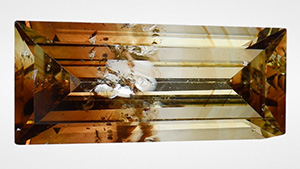
Pleochroic colors caused by cyclic twinning produce a kaleidoscope effect in alexandrite.
Read More
Two Australian rough diamonds demonstrate both pink and colorless sections in the same crystal.
Read More
A tapered baguette-cut diamond exhibits two major color zones.
Read More
A rare and exceptional example of sodalite is studied in the Bangkok laboratory.
Read More
Large blue and pink diamonds were among the top lots of the fall auction season, including the most expensive auction jewel of 2023.
Read More
A report on a new blue variety of amblygonite-montebrasite from Rwanda.
Read More
A look at a rare volcanic glass from central Oregon with lapidary artist Tom Dodge.
Read More
Investigates the various chromophores responsible for color in four types of yellow sapphire.
Read More
An examination of three Burmese chameleon amber specimens using 3D fluorescence spectroscopy.
Read More